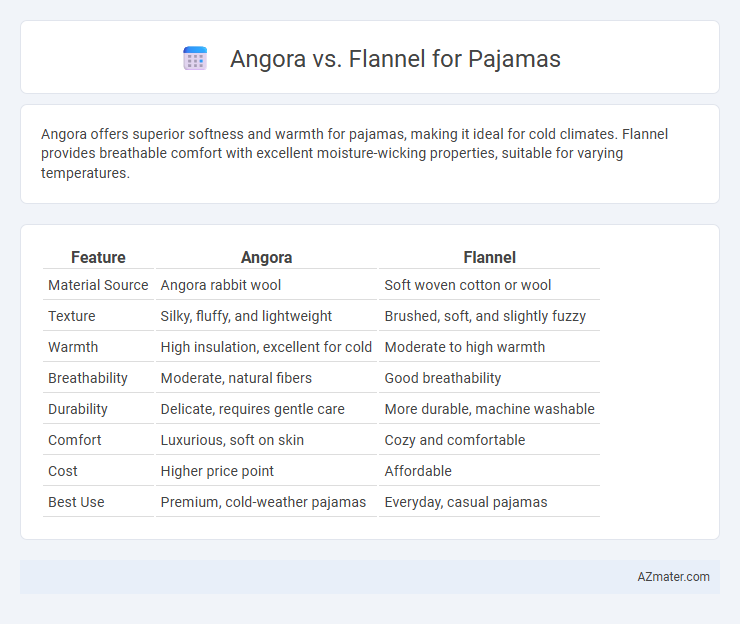Angora offers superior softness and warmth for pajamas, making it ideal for cold climates. Flannel provides breathable comfort with excellent moisture-wicking properties, suitable for varying temperatures.
Table of Comparison
| Feature | Angora | Flannel |
|---|---|---|
| Material Source | Angora rabbit wool | Soft woven cotton or wool |
| Texture | Silky, fluffy, and lightweight | Brushed, soft, and slightly fuzzy |
| Warmth | High insulation, excellent for cold | Moderate to high warmth |
| Breathability | Moderate, natural fibers | Good breathability |
| Durability | Delicate, requires gentle care | More durable, machine washable |
| Comfort | Luxurious, soft on skin | Cozy and comfortable |
| Cost | Higher price point | Affordable |
| Best Use | Premium, cold-weather pajamas | Everyday, casual pajamas |
Introduction to Angora and Flannel Pajamas
Angora pajamas are crafted from angora wool, known for its exceptional softness, warmth, and lightweight feel, making them ideal for chilly nights. Flannel pajamas feature a soft, woven fabric typically made from cotton or wool, prized for its insulating properties and cozy texture. Both materials offer comfort and warmth, with angora emphasizing luxury and flannel providing durable, breathable warmth for pajamas.
Fabric Origins: What is Angora? What is Flannel?
Angora fabric originates from the Angora rabbit, known for its silky, lightweight wool that offers exceptional warmth and softness, making it ideal for cozy pajamas. Flannel, traditionally made from cotton, wool, or synthetic fibers, is a soft woven fabric characterized by its slightly napped surface, providing warmth and breathability perfect for sleepwear. Both fabrics have distinct origins and textures, with Angora prized for luxury and insulation, while Flannel excels in comfort and durability.
Texture and Comfort Comparison
Angora pajamas offer a luxurious, soft texture with a lightweight and breathable feel, making them ideal for gentle warmth and comfort. Flannel pajamas provide a cozy, brushed texture that is thicker and warmer, perfect for cold weather and a snug fit. The choice between Angora and Flannel depends on preference for softness versus insulation, with Angora excelling in smoothness and Flannel in warmth retention.
Warmth and Insulation Capabilities
Angora fibers provide exceptional warmth and insulation, offering a lightweight yet highly effective barrier against cold temperatures due to their hollow core structure that traps heat. Flannel, made from tightly woven cotton or wool, delivers reliable warmth by retaining body heat and providing soft, insulating layers, making it ideal for cooler climates. Angora pajamas excel in thermal regulation and luxurious softness, whereas flannel pajamas combine durability with consistent heat retention for all-night comfort.
Breathability and Moisture Management
Angora pajamas offer exceptional breathability due to the natural fibers that allow air circulation while retaining warmth, making them suitable for cooler nights without overheating. Flannel, typically made from cotton or wool, provides moderate breathability but excels in moisture absorption, effectively managing sweat to keep the skin dry. When choosing between Angora and flannel for pajamas, consider Angora for superior temperature regulation and flannel for enhanced moisture wicking and softness.
Durability and Long-term Wear
Angora fibers provide exceptional softness but are less durable than flannel, making them prone to pilling and wear when exposed to frequent washing. Flannel, typically made from cotton or wool blends, offers superior durability and maintains its integrity over long-term use, resisting thinning and fraying. For pajamas, flannel is a more practical choice for everyday wear due to its robust construction and lasting comfort.
Allergy Considerations: Sensitive Skin Concerns
Angora pajama fabric, derived from Angora rabbit fur, offers exceptional softness but may trigger allergic reactions in individuals with sensitive skin due to its allergenic proteins. Flannel, typically made from cotton or wool blends, provides a hypoallergenic option that is gentle and breathable, reducing the risk of irritation and allergic response. For sensitive skin concerns, flannel pajamas are generally preferred as they minimize the chance of itching, redness, and discomfort associated with allergen exposure.
Style and Aesthetic Appeal
Angora pajamas exude luxury with their soft, fluffy texture and elegant sheen, offering a sophisticated and cozy aesthetic ideal for upscale loungewear. Flannel pajamas provide a rustic, casual charm through their signature brushed cotton weave and plaid patterns, creating a warm, timeless style perfect for relaxed, everyday wear. The choice between Angora and flannel hinges on whether one prefers refined elegance or comfortable, classic appeal in sleepwear.
Pricing and Affordability
Angora pajamas typically come with a higher price tag due to the luxurious and soft nature of Angora fibers, making them less affordable for budget-conscious shoppers. Flannel pajamas offer a more economical alternative, made from cotton or synthetic blends that provide warmth and comfort at a fraction of the cost. Consumers seeking affordable sleepwear often prefer flannel for its cost-effective durability and widespread availability.
Which Fabric is Best for Pajamas?
Angora fabric offers exceptional softness and warmth, making it ideal for cozy winter pajamas, whereas flannel provides a durable and breathable option that is excellent for regulating body temperature. Angora's lightweight yet insulating properties suit those seeking luxury and comfort, while flannel's moisture-wicking and easy-care features appeal to practical, everyday wear. Choosing between angora and flannel depends on prioritizing either plush warmth or versatile durability in pajama fabrics.

Infographic: Angora vs Flannel for Pajama
 azmater.com
azmater.com